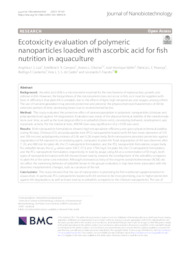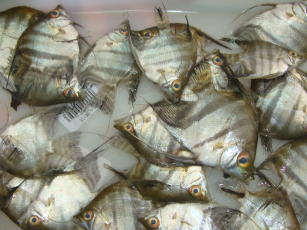Ecotoxicity evaluation of polymeric nanoparticles loaded with ascorbic acid for fish nutrition in aquaculture.
Ecotoxicity evaluation of polymeric nanoparticles loaded with ascorbic acid for fish nutrition in aquaculture.
Author(s): LUIS, A. I. S.; CAMPOS, E. V. R.; OLIVEIRA, J. L. de; VALLIM, J. H.; PROENÇA, P. L. de F.; CASTANHA, R. F.; CASTRO, V. L. S. S. de; FRACETO, L. F.
Summary: Abstract: Background: Ascorbic acid (AA) is a micronutrient essential for the mechanisms of reproduction, growth, and defense in fish. However, the biosynthesis of this micronutrient does not occur in fish, so it must be supplied with food. A difficulty is that plain AA is unstable, due to the effects of light, high temperature, and oxygen, among others. The use of nanoencapsulation may provide protection and preserve the physicochemical characteristics of AA for extended periods of time, decreasing losses due to environmental factors. Method: This study evaluated the protective effect of nanoencapsulation in polymeric nanoparticles (chitosan and polycaprolactone) against AA degradation. Evaluation was made of the physicochemical stability of the nanoformulations over time, as well as the toxicological effects in zebrafish (Danio rerio), considering behavior, development, and enzymatic activity. For the statistical tests, ANOVA (two-way, significance of p < 0.05) was used. Results: Both nanoparticle formulations showed high encapsulation efficiency and good physicochemical stability during 90 days. Chitosan (CS) and polycaprolactone (PCL) nanoparticles loaded with AA had mean diameters of 314 and 303 nm and polydispersity indexes of 0.36 and 0.28, respectively. Both nanosystems provided protection against degradation of AA exposed to an oxidizing agent, compared to plain AA. Total degradation of AA was observed after 7, 20, and 480 min for plain AA, the CS nanoparticle formulation, and the PCL nanoparticle formulation, respectively. For zebrafish larvae, the LC50 values were 330.7, 57.4, and 179.6 mg/L for plain AA, the CS nanoparticle formulation, and the PCL nanoparticle formulation, respectively. In toxicity assays using AA at a concentration of 50 mg/L, both types of nanoparticles loaded with AA showed lower toxicity towards the development of the zebrafish, compared to plain AA at the same concentration. Although decreased activity of the enzyme acetylcholinesterase (AChE) did not affect the swimming behavior of zebrafish larvae in the groups evaluated, it may have been associated with the observed morphometric changes, such as curvature of the tail. Conclusions: This study showed that the use of nanosystems is promising for fish nutritional supplementation in aquaculture. In particular, PCL nanoparticles loaded with AA seemed to be most promising, due to higher protection against AA degradation, as well as lower toxicity to zebrafish, compared to the chitosan nanoparticles. The use of nanotechnology opens new perspectives for aquaculture, enabling the reduction of feed nutrient losses, leading to faster fish growth and improved sustainability of this activity.
Publication year: 2021
Types of publication: Journal article
Unit: Embrapa Environment
Related content
Observation
Some of Embrapa's publications are published as ePub files. To read them, use or download one of the following free software options to your computer or mobile device. Android: Google Play Books; IOS: iBooks; Windows and Linux: Calibre.
Access other publications
Access the Agricultural Research Database (BDPA) to consult Embrapa's full library collection and records.
Visit Embrapa Bookstore to purchase books and other publications sold by Embrapa.


